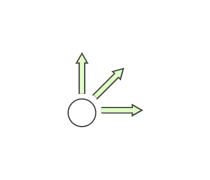Which one of the following is an example of a vector quantity?
A swimmer heading directly across a river 200 m wide reaches the...
Which of the following operations will not change a vector?
A soccer ball is kicked with a velocity of 25 m/s at an angle of...
Two displacement vectors have magnitudes of 5.0 m and 7.0 m,...
On a calm day (no wind), you can run a 1500-m race at a velocity of...
Ignoring air resistance, the horizontal component of a...
An Olympic athlete throws a javelin at four different angles above the...
A ball is thrown at an original speed of 8.0 m/s at an angle of...
You are traveling at 55 mi/h in the +x axis relative to a straight,...
A plane has an air speed of 200 m/s due North, and is in a wind of...
A ball is thrown with a velocity of 20 m/s at an angle of 60°...
A plane is flying due South (270°) at 500 km/h. A wind blows from...
Ignoring air resistance, the horizontal component of a...
If the acceleration vector of an object is directed anti-parallel to...
The acceleration of gravity on the Moon is only one-sixth of that on...
At what angle should a water-gun be aimed in order for the water to...
If a ball is thrown with a velocity of 25 m/s at an angle of 37°...
Three forces, each having a magnitude of 30 N, pull on an object in...
A pilot drops a bomb from a plane flying horizontally at a constant...
A projectile is launched with an initial velocity of 60.0 m/s at an...
A ball thrown horizontally from a point 24 m above the ground, strikes...
A plane flying horizontally at a speed of 50.0 m/s and at an elevation...
A 400-m tall tower casts a 600-m long shadow over a level ground. At...
Your motorboat can move at 30 km/h in still water. How much time will...
Which of the following is an accurate statement?
A girl throws a rock horizontally, with a velocity of 10 m/s, from a...
A rifle bullet is fired at an angle of 30° below the horizontal...
Two vectors, of magnitudes 20 and 50, are added. Which one of the...
If the acceleration of an object is always directed perpendicular to...
A projectile is launched with an initial velocity of 60.0 m/s at an...
A fighter plane moving 200 m/s horizontally fires a projectile with...
A runner runs halfway around a circular path of radius 10 m. What is...
The driver of a motorboat that can move at 10 m/s in still water...
When a football in a field goal attempt reaches its maximum height,...
A stone is thrown horizontally with an initial speed of 10 m/s from...
A swimmer heading directly across a river 200 m wide reaches the...
The resultant of two vectors is the smallest when the angle between...
A stone is thrown horizontally from the top of a tower at the same...
A butterfly moves with a speed of 12.0 m/s. The x component of its...
A car travels 20 km West, then 20 km South. What is the magnitude of...
You are throwing a ball for the second time. If the ball leaves your...
You are trying to cross a river that flows due south with a strong...
A boat, whose speed in still water is 8.0 m/s, is directed across a...
An airplane with a speed of 120 km/h is headed 30.0° east of north...
If you walk 6.0 km in a straight line in a direction north of east and...
A package of supplies is dropped from a plane, and one second later a...
A jumper in the long-jump goes into the jump with a speed of 12 m/s at...
The driver of a motorboat that can move at 10 m/s in still water...
A bullet is fired horizontally, and at the same instant a second...
A jumper in the long-jump goes into the jump with a speed of 12 m/s at...
















